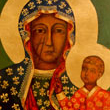Our Lady of Czestochowa

Michael P. Duricy
The image of Our Lady in Częstochowa, Poland [right] is among that small group of Black Madonnas recognized throughout the entire world, largely due to the recent manifestations of public piety shown by, John Paul II. The image is sometimes called Our Lady of Jasna Góra after the name of the monastery site in which it has been kept for six centuries. Joan Carroll Cruz relates the following ‘miracle story’ regarding the selection of this site:
St. Ladislaus determined to save the image from the repeated invasions of the Tartars by taking it to the more secure city of Opala, his birthplace. This journey took him through Częstochowa, where he decided to rest for the night. During this brief pause in their journey, the image was taken to Jasna Gora [meaning “Bright Hill”]. There it was placed in a small wooden church named for the Assumption. The following morning, after the portrait was carefully replaced in its wagon, the horses refused to move. Accepting this as a heavenly sign that the portrait was to remain in Częstochowa, St. Ladislaus had the image solemnly returned to the Church of the Assumption.
Another ‘miraculous’ aspect of this image is that its antiquity is so great that its origins are unknown, as if “dropped from the heavens.” Legend attributes its creation to St. Luke, the evangelist, who “painted a portrait of the Virgin on the cedar wood table at which she had taken her meals. “St. Helena, the Queen-Mother of Emperor Constantine is said to have located the portrait during her visit to the Holy Land and to have brought it to Constantinople in the fourth century. After remaining there for five centuries, it allegedly was transferred in royal dowries until it made its way to Poland, and the possession of St. Ladislaus in the fifteenth century.
The legend continues: During Ladislaus’ time, the image was damaged during a siege, by a Tartar arrow, “inflicting a scar on the throat of the Blessed Virgin.” In 1430, Hussites stole and vandalized the precious image, breaking it into three pieces. Adding insult to injury:
One of the robbers drew his sword, struck the image and inflicted two deep gashes. While preparing to inflict a third gash, he fell to the ground and writhed in agony until his death … The two slashes on the cheek of the Blessed Virgin, together with the previous injury to the throat, have always reappeared – despite repeated attempts to repair them.
However, modern scholarship has its own views on this legend. Leonard Moss claims: “the figure is distinctly thirteenth-fourteenth century Byzantine in form.” In general, its Byzantine style is obvious, a variant on Hodegetria. Janusz Pasierb states of the image that “in 1434 it was painted virtually anew” due to the extensive damage caused by vandalism. He adds that “the authors of the new version were faithful to the original as regards its contents.” This might explain the persistence of the damage marks mentioned earlier. Finally, note that Pasierb sees the prototype of Our Lady of Częstochowa as “a Byzantine icon … which from the fifth century on had been worshipped in a church in Constantinople’s ton hodegon quarter.”
